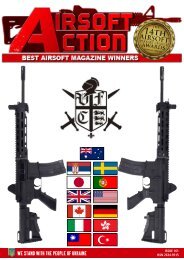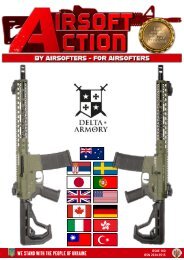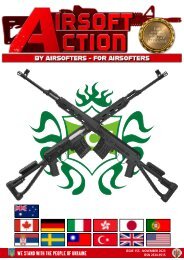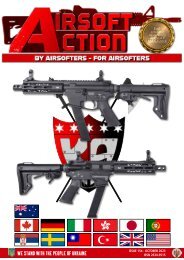PMCI - February 2017
Welcome to a whole new year of Private Military Contractor International. The team hit the ground running with this issue following a very successful visit to SHOT Show 2017 in Las Vegas which is reported fully. This issue also has an in depth interview with Dark Angel Medical and reviews of new knives and tools from SOG, an innovative lighting system for your AR and an overview of a revolutionary new training tool. If you’re working in the private military sector then PMCI is the magazine for you!
Welcome to a whole new year of Private Military Contractor International.
The team hit the ground running with this issue following a very successful visit to SHOT Show 2017 in Las Vegas which is reported fully.
This issue also has an in depth interview with Dark Angel Medical and reviews of new knives and tools from SOG, an innovative lighting system for your AR and an overview of a revolutionary new training tool.
If you’re working in the private military sector then PMCI is the magazine for you!
You also want an ePaper? Increase the reach of your titles
YUMPU automatically turns print PDFs into web optimized ePapers that Google loves.
pmcimagazine.com<br />
SPECIAL REPORT: A SOLDIER’S LOAD<br />
THE UNIVERSAL SOLDIER’S BURDEN<br />
We spend a lot of time discussing the benefits of improved equipment, but some things never change<br />
according to former Para Peter Bing…<br />
Friday morning, 20th of January <strong>2017</strong>, found me<br />
driving through the quiet outskirts of Colchester<br />
(Essex, England) with my 85 year-old-father when,<br />
quite unexpectedly, wheeling around the corner<br />
and coming towards us in column of threes came a<br />
company of Parachute Regiment soldiers.<br />
They were, in Para vernacular, tabbing (from<br />
TAB - Tactical Advance to Battle) in boots, MTP<br />
trousers (boots and denims in my day), sporting<br />
maroon sweatshirts and carrying large Bergen rucksacks.<br />
All were blowing hard from the effort, with jaws set in a<br />
determination that can only be appreciated if you have been<br />
a Para (or respectfully, belonged to another elite unit), with<br />
each one leaning forward into his burden to maintain balance<br />
as they “scampered” (you cannot adopt the stride of a normal<br />
runner when carrying that kind of weight) at a blistering pace<br />
on their morning company run. Each soldier loaded, I would<br />
bet, with a rucksack weighing at least 60lbs, before the<br />
addition of weapon and supporting combat load that they were<br />
not carrying that morning.<br />
Focused on the task at hand, no one took noticed of our<br />
passing vehicle, and even if they had, none would have had<br />
any idea that the two veteran Paratroopers sitting inside were<br />
taking in the scene with a mixture of nostalgia and pride. For<br />
my father the Parachute Regiment experience began in 1951<br />
after serving in Korea with the Argyles, and for me it started<br />
in 1970 from school. What we were looking at was a scene<br />
(Aldershot, not Colchester, in our day) we had both experienced<br />
many, many, times over, being conducted by young men who<br />
could have been either of us from our own Para generations.<br />
That brief scene got me to thinking “nothing much changed<br />
there then”. January <strong>2017</strong> and the infantryman’s lot is still to<br />
struggle to get himself physically into battle under a mountain<br />
of kit and equipment; as he did in the town of Colchester,<br />
when infantry on that same road 2000 years ago were Roman<br />
legionnaires, who referred to themselves as “Marius’ Mules”<br />
after the general who loaded them down with so much<br />
equipment. As an aside, Colchester is my hometown, so I<br />
may well be descended from one such individual? Of course,<br />
it is necessary for specialist infantry like paratroopers to be<br />
fit enough and strong enough to bear the burden, because<br />
unlike mechanized units, once parachuted or helicoptered onto<br />
the area of operations they are dependent on muscle power<br />
alone. But what studies, as far as the British Army is concerned,<br />
have been undertaken to reduce and redistribute that load, I<br />
thought? Many, as you would rightly expect.<br />
As far back as the 1860s army medical services were<br />
concerned that too many soldiers were sustaining permanent<br />
debilitating injury from the loads they were expected to carry,<br />
to the extent that too many dropped by the wayside on an<br />
advance to battle, or were too physically exhausted to contribute<br />
in any meaningful way to the assault. Again in the 1890s after<br />
the experiences of the South African War, with its environment<br />
challenges, amongst others, military committee examined<br />
the subject of lighter combat loads and better load carrying<br />
equipment. Changes were made and the soldier of WW1 was<br />
issued with a “state of the art” set of load carrying equipment.<br />
50


















